Designation of sockets and switches in the drawings and diagrams
Any type of electrical installation is carried out in accordance with the project. It contains instructions on the placement of equipment and wiring elements at the facility.
The symbol for sockets and switches in the drawings has a single standard. This eliminates confusion and clearly demonstrates any nuances of installation work.
The content of the article:
Regulatory documents
So that a specialist of any category could navigate the project, SNiPs and GOSTs were developed, which regulate, among other things, the designation of various types of sockets and switches in the drawings and wiring diagrams. One of them is GOST 21.210-2014.
All types of appliances presented in the form of simple geometric shapes for ease of image and reading. In order to standardize the type of symbols, they use the documents of the International Electronical Commission (IEC), and in particular, the standard IEC 60027.

However, the presentation of wiring is made in different types of documentation and has some differences. For example, the type of outlet and switch in the construction drawing and wiring diagram has a significant difference, since these documents have different purposes.
The main types of outlets
An electrical outlet (receptacle) is a device that allows you to quickly turn on and off various devices from the network.
Its main elements are:
- contacts - provide connection of the power supply network and plugs;
- block - a ceramic case for contacts and mountings of the installation box (socket box);
- body - performs a decorative and protective role.
In the general sense of the word, a product can perform other functions.For example, to connect and disconnect telephone communications, radio, Internet and even water supply in plumbing devices. Therefore, there are many constructive and functional variations of this type of connection.
The main types of outlets used in everyday life vary:
- depending on the installation method, there is an invoice and built-in;
- by the number of nests - a single or a block of two, three or more;
- by the number of connections - with and without grounding contact;
- as intended - an antenna, for telephone and the Internet, for household appliances, for powerful equipment.
Simple and versatile to install is overhead device. It does not require making deep holes in the wall, which is convenient for temporary placement or in industrial premises. The case together with the block is mounted on the desired surface and connected to an open wiring.
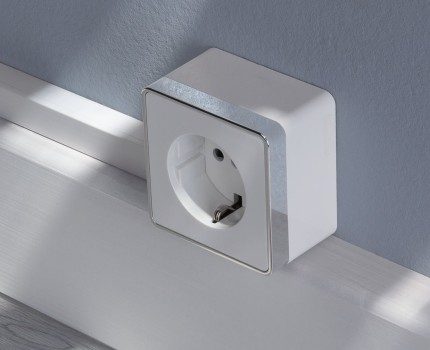
The built-in installation option has a more aesthetic appearance, since the main part of the product is immersed in the wall, and only the protective case remains outside. Thus, nothing interferes with the perception of the interior of the room.
The posting in this case is rather hidden too. For this type of fastening, a cylindrical hole is cut into the wall into which the mounting box is mounted. It reliably and safely fixes the outlet in the wall.
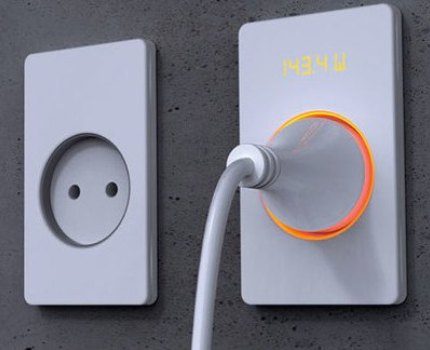
The option with two sockets is designed to connect two plugs to the network at once. With flush mounting, the block is placed in one socket.
To increase their number (more than two), you will have to make an additional hole in the wall and combine the body with one frame, if a hidden installation is supposed. If the model is an invoice, then modular pads are added.
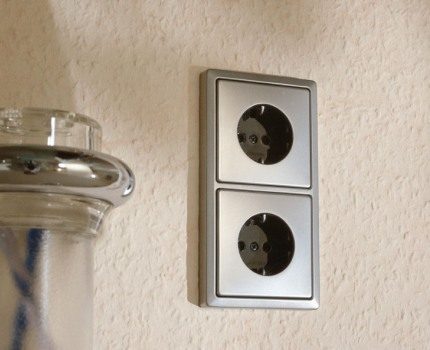
The modern look of the outlet is with a grounding contact. It is used in networks with a grounding wire that are safer than phase, zero networks.
Additional terminals are connected to this wire. They are primarily in contact with the plug, which eliminates the hazardous voltage and current of faulty household appliances. It also protects the equipment from interference in the network and electromagnetic interference from other devices.
Antenna has no voltage. It serves to connect the TV to the antenna cable. The external difference is only the type of inlet in the housing.
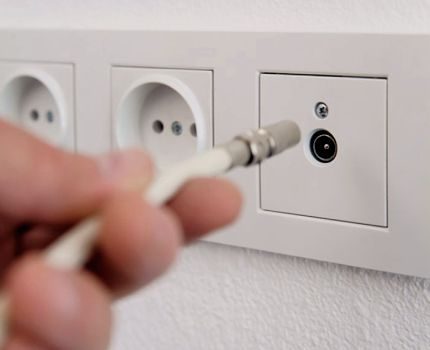
A computer outlet is used to connect to the Internet and local networks. You can also connect a telephone cable to it.
The Internet and telephone cable connectors are identical in shape - RJ45 and RJ11 / 12, respectively. The first uses 8 contacts, and the second 4 or 6. But to connect to the Internet through a telephone jack, you will have to use a modem that uses a Dial-up connection.
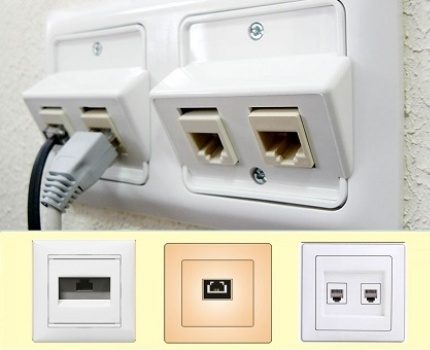
Such devices can be executed in a compact case or in the form of a conventional 220 V. To connect a telephone with an old-style connector, you will need to install a socket with the appropriate input.
Degree of equipment protection
Sockets, like any electrical equipment, have a different level of protection against the contact of parts under voltage, with solid particles and water.This ensures safe human use in a variety of conditions.
A combination of two letters (IP) and two numbers is used to mark the degree of protection. IP - International Protection, which translates from English as "international protection." And the numbers characterize her level.
For example, the degree of protection IP20 according to GOST 14254-2015 can be deciphered as follows:
- first number 2 - current-carrying parts of the product are inaccessible to objects 12.5 mm thick or fingers;
- second digit 0 - water may get into the device.
The degree of protection IP23 means that fingers are prevented from getting inside, and the angle of safe drops falling on the case is 60 degrees.
Conditionally graphic designation
GOST 21.210-2014 unifies the image of electrical elements in diagrams. Makes them universal throughout Russia.
The designations of the outlets presented in this document can be conditionally divided according to several signs:
- open installation;
- hidden installation;
- waterproof.
An open network connection does not imply hiding the pads in the wall plane. There are varieties with two and three poles, with protective contact, as well as double or single. Usually, overhead placement is used in rooms with open wiring.
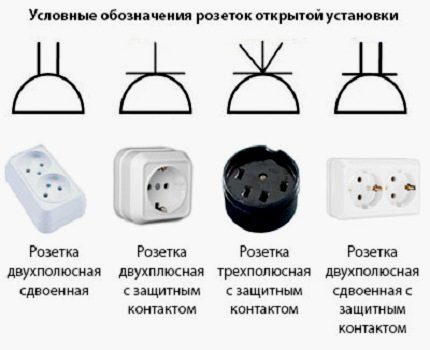
Concealed connection differs from the previous one by a socket block immersed in a wall or other surface. It connects to the contacts of the hidden wiring.
According to the degree of protection, open and hidden products do not differ among themselves. And placement inside the wall does not make them more dangerous.
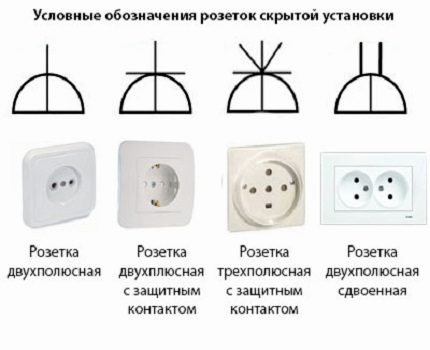
Devices with a waterproof housing are usually installed in places of high humidity. This may be a bathroom, kitchen or poorly protected from moisture places outside the building.
The degree of protection is from IP44 to IP55. In the first case, this means that objects with a thickness of more than 1 mm will not get inside, and the protection against moisture is resistance to rain. In the second - protection against dust and safe operation under weak streams of water.
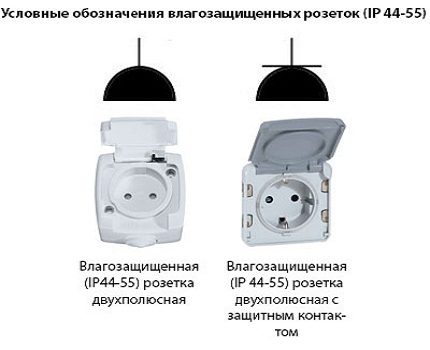
Separately, it should be said about the classification by the number of poles. There can be from two to four. In Russia, bipolar sockets with protective contact are mainly used.
All household appliances are powered by this type. Multi-pole, namely with three poles, feed industrial equipment: machine tools, pumps, electric furnaces. They are used in three-phase networks.

The main types of household switches
When developing a plan for the electrification of a room, it is necessary to accurately determine the type of switches. The market presents a mass of such products of various shapes, purposes and devices.
Product classification principles
Structurally, the switch resembles a receptacle. Their components are similar: contacts, block and protective cover. But if the socket is used to connect to the electrical network, the switch is designed to open this connection by manually acting on the changeover contact.
It opens the only (phase) wire coming into it, in contrast to the outlet. And also closes by pressing the button again. Like sockets, switches have several levels of protection: from IP20 to IP23 and from IP44 to IP55.
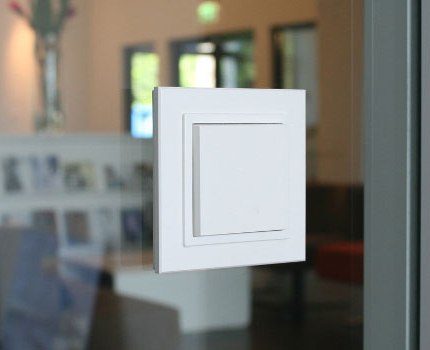
To clarify the choice of suitable options, it is enough to systematize them according to several principles.
For example, there is a classification according to the following criteria:
- way of switching;
- type of installation;
- by type of shutdown and on.
In addition, they can be divided according to the principle of operation: one-, two-, three-pole and switches in two directions without a zero position.
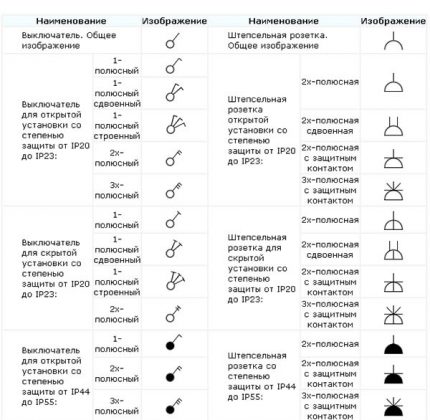
All variants of symbols, expressed in alphabetic and graphic form, given here. We recommend that you familiarize yourself with useful information.
Ways of switching and installation
The option of connecting circuit breakers with a live wire can be screw and screwless. In the first case, the contact is provided by pressing the wire to the switch plates with a screw. over time, such a connection may weaken, which leads to heating of the element. Periodically, it must be tightened to a tight grip.
In the second case, the phase wire is fixed with self-clamping terminals. This makes connecting much easier and faster. The connection quality in the terminal is more reliable and does not require further disassembling the switch to strengthen the contact.
Depending on the location of the wiring, the switches can be built into the wall or overhead. In residential or office premises with hidden wiring for the sake of appearance, the switches are mounted on the wall. If the wiring is open, when there are no stylistic requirements for the interior of the room, switching devices are mounted openly on the wall surface.
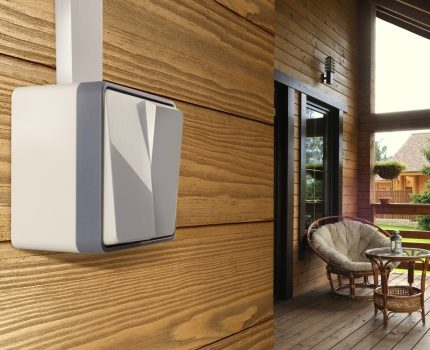
Contact closure options
The most common type of household switch is a keyboard. The principle of its operation is based on opening and closing a contact by switching the key on which the frame is fixed. In the on state, it touches the static contact and closes the electrical circuit. According to the connection scheme, they are cross over and cross type.
Pushbutton switches work in the same way as keyboard switches. In everyday life, they are most often used in table lamps and floor sconces. The button can be locked when turned on or close the circuit only when it is held.
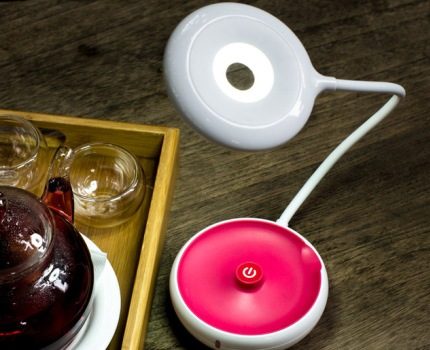
In wall sconces or in technical rooms, where the permissible height of the electrical equipment does not allow reaching by hand, products with a cord are used. According to the device, they are basically similar to button ones.
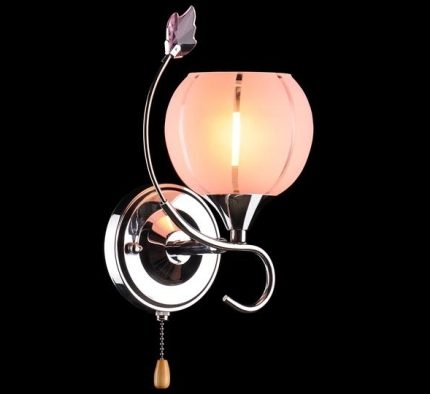
Rotary types of switches, as a rule, open mounting. They began to be used more than a hundred years ago, and they worked only in the on / off position and had a very exotic look.
Even today, these devices work in ancient buildings and house-museums. And recently, they have received a second wind and are used in the design of interiors stylized as retro or steampunk, having gained wider functionality.

The opposite of the rotary was the touch switch. This new trend of technology not only received a futuristic design and a fundamentally new way of control, but also increased the reliability and safety of use.
After all, these semiconductor devices do not have a switching mechanism - electronics are responsible for everything. They are actively used in the management of the "smart home" system. Devices work both on pressing and on its intensity, on approaching the palm and even on the voice.
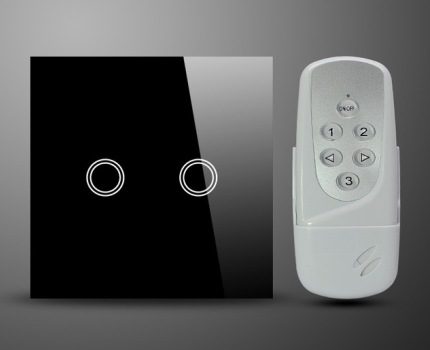
The motion sensors in them relieve the discomfort of entering a dark room, turning on the light automatically, and the temperature sensor allows you to synchronize the switch with the fireplace. Recent models are able to respond to gestures and smoothly change the brightness of lighting.
Number of poles of switches
According to GOST R 52565-2006, the pole is an element of the switching apparatus, which is connected to only one independent part of the circuit. In simple words, the pole closes only one line, for example, a light bulb.
There is some confusion regarding the poles of switches and their purpose. To understand, you first need to separate the concepts of automatic and conventional lighting switch in the room.
Automatic switches are equipped with one / four poles when three phases and a neutral wire are closed. Such switches are placed in the power panels of the room to protect against overloads and short circuits.
If we talk about light switches, the number of poles means how many lines can be switched on in isolation from each other. For example, several lighting groups in a room can be turned on with a single three-gang switch. For the same purpose, you can install three single-pole devices, which is less convenient.
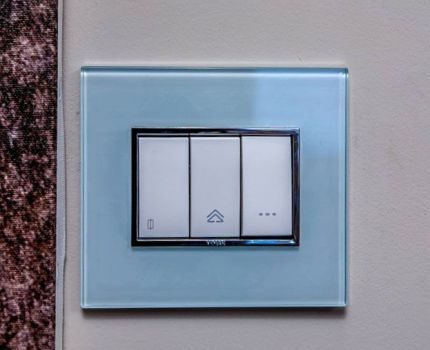
A two-way switch is used in the design of complex light control circuits from several places.
These devices can be in a zero (neutral) position. This is convenient, for example, when lighting long corridors or flights of stairs, when you turn on the light at the beginning, you can turn it off at the end.
Conclusions and useful video on the topic
Overview of electrical elements as an example of a floor plan:
When installing electrical equipment, masters of any level and direction should not have misunderstandings with the designer who developed the power supply plan. Therefore, with all the variety of electrical products and methods of its application, the graphic symbols on the construction drawings and diagrams should have one general view and standard.
Please write comments in the block below. Share interesting information and information that will be useful to site visitors. Ask questions, express your own opinion on the topic and the material proposed by us, publish a photo.

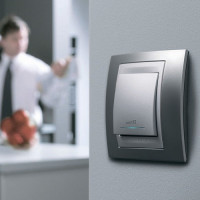 Installation height of sockets and switches: where and how to position?
Installation height of sockets and switches: where and how to position? 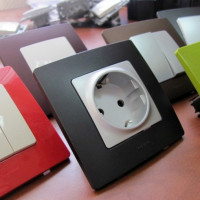 Types of electrical outlets and switches: what are and how to choose wisely
Types of electrical outlets and switches: what are and how to choose wisely 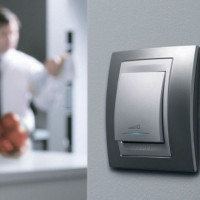 Types and types of light switches: an overview of connection options + analysis of popular brands
Types and types of light switches: an overview of connection options + analysis of popular brands 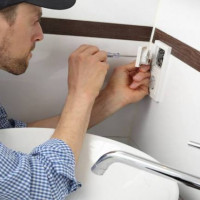 Installation of sockets in the bathroom: safety standards + installation instruction
Installation of sockets in the bathroom: safety standards + installation instruction 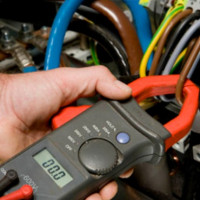 Isolation of circuit breakers: insulation requirements for domestic and industrial appliances
Isolation of circuit breakers: insulation requirements for domestic and industrial appliances 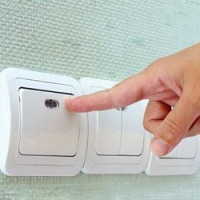 How to install a light switch: step-by-step instructions for connecting typical switches
How to install a light switch: step-by-step instructions for connecting typical switches  How much does it cost to connect gas to a private house: the price of organizing gas supply
How much does it cost to connect gas to a private house: the price of organizing gas supply  The best washing machines with dryer: model rating and customer tips
The best washing machines with dryer: model rating and customer tips  What is the color temperature of light and the nuances of choosing the temperature of the lamps to suit your needs
What is the color temperature of light and the nuances of choosing the temperature of the lamps to suit your needs  Replacement of a geyser in an apartment: replacement paperwork + basic norms and requirements
Replacement of a geyser in an apartment: replacement paperwork + basic norms and requirements
We made a diagram of the entire apartment (we changed the old wiring and shifted the outlet of the sockets), called the master, who said to buy recessed switches and sockets. They bought what they said, ceramics sockets. The next day he came to install them, and could not. For what reason it is not clear, but asked to change to convex. Well, we went and changed, and in the end he again said that those first are needed! We freaked out and told us to change. As a result, he put devices for hidden wiring, but not on ceramics, but others. Question: how safe is it, how much should they be changed ?! Who knows?! There are no electricians in the family, but there is no confidence in the master either.
Do not worry, Svetlana, the next repair of electricians will come in fifteen years. Of course, ceramic sockets, switches are reliable devices, but plastic is also good. My ceramics have been serving for 13 years, plastic has not changed either. True, plastic sockets have lost color, while ceramic ones are still snow-white.
About the 15-year milestone said, based on a regulatory document - called the "Rules for assessing the physical deterioration of residential buildings." There is a schedule of depreciation of electric networks (screenshot - attached).
The designation of sockets and switches on the circuits I remember from school, we had a wonderful and meticulous physics teacher. When you know how to read the circuit, it becomes much easier to understand the circuit. Needless to say, I change all sockets and switches in my house myself. By the way, the outdoor wiring looks very vintage, but I did not dare, now I'm sorry.